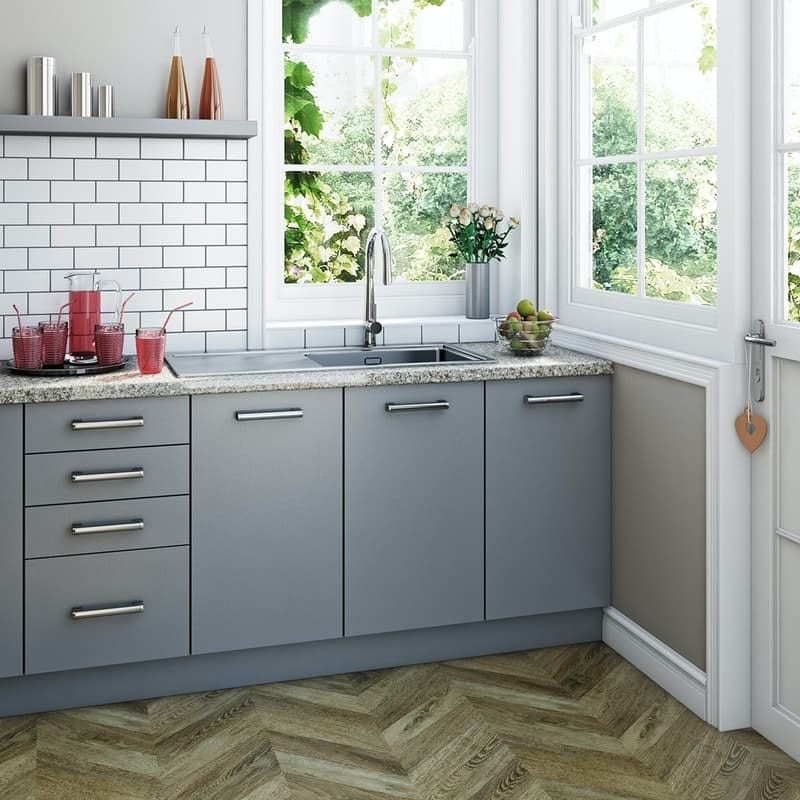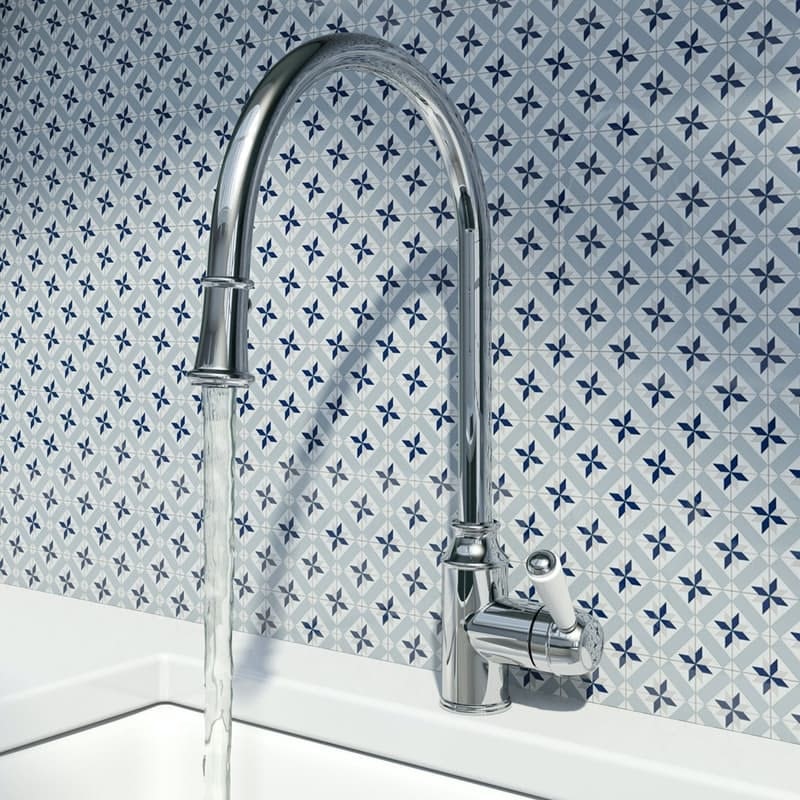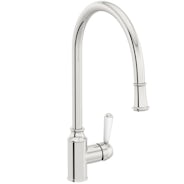Time for change? Why not fit that shiny new kitchen tap yourself? We explain how…
Whether installing standard pillar or mixer kitchen taps, the installation is quite similar, and can be done by anyone with a good amount of DIY experience. If you want to learn how to fit a kitchen tap (very similar to changing a bathroom tap), then read our guide below.
Tools you may need
Some of the tools you may need to use to fit a kitchen tap include:
- Box cut spanner
- Cleaning cloth
- Adjustable spanner
- Pliers
- Compression fittings or check valves (if needed)
- Pipe cutter
- New tap fittings
- Basin wrench
- Towel
- Container bowl
- Olive splitter
Before you can install new taps in the kitchen you need to remove the old tap(s), which we explain how to do below:
Step 1: Turn off the water
The first thing to do is to turn off the water supply pipe coming into the kitchen taps (you don’t need to turn off the mains water supply). Look for isolation valves connected to the outputs of the flexible hoses or pipes supplying the water. You’ll either need to use a screwdriver to turn the slotted screw head or switch the thumb lever to turn off the supply, turning about quarter of the way and stopping once the slot or lever is at a right angle. To check the water supply is off, turn on each tap.
If there are no independent isolator valves, close the main water supply stopcock. The hot water supply tank should also have a valve that needs to be turned off. Finally, run the hot and cold water taps to double check the water supply is off.
When the time comes to replace your tap, why not choose something elegant like this traditional design from Schön?
Step 2: Prepare the space
Before you start work, you should clear the space underneath the kitchen sink to allow safe and easy access to the pipes. It’s also a good idea to lay down at least one towel and have a bowl beneath the sink, so you can catch any water which may leak out as the pipes are disconnected.
Step 3: Disconnect the tap
If you have a standard pipe connection, loosen the nut where the tap joins the pipe using a box spanner. As you loosen the nut, hold the tap so it doesn’t twist along with the movement of the spanner. Water is likely to run out of the pipe at this stage, so use the bowl to catch it. For taps with flexible hoses, loosen the nuts at the point where it is joined to the isolator valves or water pipe connections. Hold the valve or connect with the spanner (water pump pliers are also a good tool) and loosen slowly—it may be a bit tight at first as it will stiffen over time. One at a time, remove the brass/copper olive from each of the pipes—you can use the olive splitter if they are jammed.
A replacement kitchen tap, like the Eilean pull out tap from Schön, can add a whole new dimension to your kitchen design
Step 4: Remove the old kitchen tap(s)
With the water supply off and taps disconnected, you can start to remove the tap. Loosen the nut connecting it to the mounting surface while holding on to the tap to prevent it from moving. If the mains pipe connection is a traditional pillar or combination style that has a large retention nut, you should use a basin wrench, set to the right size, to loosen it. Once this is loosened, the tap can be removed from its position in preparation for the new one—check there isn't a rubber washer or seal from the old tap still in place. If you have a kitchen mixer tap, use either an open ended spanner or box spanner (for areas that are a little more restricted) to loosen the nut.
Once the nut has been removed from the stud, the tap and the flexible hoses can be lifted out. Some hoses may have sharp edges on the attachments, so if you own a stainless steel sink take these out carefully to avoid scratching the surface. Use a cleaning cloth to wipe away any residue or mess that may have been created from the mains connection pipe.
How to change a kitchen tap
Now you are ready to fit new kitchen taps and attach them to the kitchen sink. Before you get started with the installation of your new kitchen tap(s), make sure they are supplied with new hoses.
Step 1: Clean up before starting installation
It’s a good idea to make sure that any residue left in the gaskets or seals from the old tap is wiped away before any work begins. Take extra care while doing this, ensuring you don't scratch the surface.
Step 2: New kitchen tap installation
Take a good look at the instructions for your new kitchen tap prior to installation, so you don’t waste too much time figuring it out as you go along. On bridge combination and individual pillar style taps, use a good amount of sealing PTFE tape (wrapping it clockwise) on the lower threads of the mains connection. Once bound, cut the PTFE tape and move on to the kitchen tap replacement.
If you are installing mixer taps, they should also come with a pre-fitted hose. For taps that don’t, screw them into place using only your hand, rather than a spanner or set of pliers. Following the instructions, carefully lower the mains connections into the kitchen sink hole. As we mentioned above, watch out for any sharp edges on stainless steel sinks and make sure that all the necessary studs, washers, o ring seals, tap connectors and gaskets are in place for the installation too.
Once the tap is securely in place, you should perform a final check that everything is aligned and fitted as per the instructions. You can then put the retaining nut back in place by hand until it is secure and tight. Use one of the tightening tools to ensure it is firmly in position. It's a good idea to have someone else hold the tap while you tighten it, to stop it from moving and ensure it remains firmly in place.
Give your kitchen the update it deserves with a pull out spray kitchen tap like this one from Schön
Step 3: Reconnect to the water supply
Now that the new kitchen tap(s) has/have been installed and water pipes underneath the sink reconnected, you now need to secure the mains connection.
If you have a bridge mixer or pillar-style basin tap, the thread will be of a standard length making it easy to align with the current connection. Use the right tool to tighten the connection and avoid overtightening. A mixer tap will already come with integral seals, so you won’t need to use PTFE tape here, and you can tighten the isolator valves or nuts on the main pipe by hand. You can then tighten further using a box spanner, again being careful not to overtighten.
Step 4: Turn the water supply off
The new taps in the kitchen should be turned off (both hot and cold water) before starting the final step. This is because you are slowly going to reconnect the water supply and if there are any problems you do not want water to come unexpectedly pouring out of the pipes.
Open either the mains stop cock or isolators and the water tank valve, keeping an eye on the connections under the sink in case there is any leakage. Wait a minute or 2. If the connections remain dry, you can proceed in slowly turning on the hot and cold water taps one at a time. The initial flow of water may splutter as it refills the water pipes but should run smoothly after a short time.
Congratulations, you have just successfully learned how to change a kitchen tap.
It’s also a good idea to keep checking the connecting pipes under the sink over the next few days to ensure no leakages occur. A similar process can be followed for installing a new tap system into the bathroom, although there are some differences.
How to change kitchen tap water pressure
If removing and cleaning the tap aerator doesn’t have any effect on the water pressure coming out the taps, you may need to flush through the pipes. This may be due to a build-up of grime or dirt or a blockage in the pipes:
-
Locate the valves on the pipes under the sink and turn them clockwise until horizontal to shut off the water supply. Place a towel underneath in case of any spillages.
-
Unscrew the thread coming down from the sink and hold it over a bucket. Loosen the nut until it disconnects from the valve keeping the end over the bucket.
-
Turn the water back on and run it for about 10 seconds to clear out the supply line.
-
Switch off the water and reattach the supply line along with nut, then turn the valve back on.
-
Follow the same procedure on the other tap and, if anything was blocking the passageway, it should now be cleared, improving the water pressure.
As with the installation of a kitchen tap, a similar process can be used in the bathroom if there is an issue with water pressure. You can find out more about water pressure in our in-depth guide.
The Schön Skomer pull out spray tap is the perfect replacement for a traditional style kitchen
Like this article?
At Victoria Plum, we're full of handy, practical advice for your kitchen, including buying guides to help you make all the right choices and DIY tips. Want to know how much kitchen installation costs? Yep, we've got a guide to that too!
Working on your bathroom? Discover hundreds of informative and helpful articles on bathrooms, like step-by-step installation guides and advice on room planning.
Shop kitchens
Searching for a replacement kitchen tap? Browse our superb kitchen range at Victoria Plum. From sinks to worktops, and from fitted units to heating, you'll find everything you need to serve up a really tasty kitchen. Click on the image below to begin shopping.











